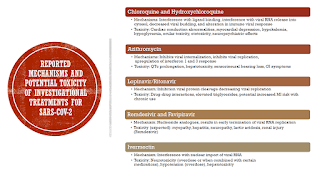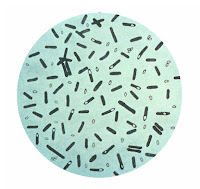Potential Treatments for SARS-CoV-2: Reported Mechanisms and Toxicity
By James Chenoweth,
MD MAS
Chloroquine and Hydroxychloroquine
Chloroquine and hydroxychloroquine are synthetic analogues of quinine, a naturally occurring extract from the bark of the Cinchona tree. Both are used as anti-malarial agents in regions without chloroquine resistance. Hydroxychloroquine is also used to treat auto-immune disorders such as rheumatoid arthritis and systemic lupus erythematosus.1
Potential mechanisms against SARS-CoV-2
Chloroquine and hydroxychloroquine have been shown to alter the production of sialic acid moieties in vitro. Sialic acids are monosaccharides that are found at the end of transmembrane proteins and often act as docking sites for viral particles. The alteration of one transmembrane protein, angiotensin converting enzyme 2 (ACE2), is thought to decrease the ability of SARS coronaviruses to bind to and enter cells.1-3 In addition to effects on binding sites, chloroquine and hydroxychloroquine may also interfere with viral entry into cell cytosol through alkalization of endosomes. The fusion of endosomes with viral membranes depends on an acidic environment inside the endosomes. Without this, fusion doesn’t occur and viral RNA is not released into the cytosol, a step necessary for viral replication.1-3
Other purported mechanisms include alteration in the pH of endoplasmic reticulum which inhibits glycosylation of some transmembrane proteins necessary for viral budding and release.2 Finally, chloroquine and hydroxychloroquine can alter the immune response to viral infection. A protective immune response occurs through increased viral protein presentation in dendritic cells which improves immune recognition of viral particles.2 Chloroquine and hydroxychloroquine also decrease inflammatory cytokine release.1-3
Potential toxicity of Chloroquine and Hydroxychloroquine
Hydroxychloroquine is a synthetic derivative of chloroquine. Chloroquine has been shown to be 2-3 times more toxic than hydroxychloroquine in animal studies.4,5 The reported lethal dose of chloroquine is 30-50 mg/kg.6 Cardiotoxicity is the primary concern with the use of chloroquine and hydroxychloroquine. Both agents exhibit quinidine like effects on cardiac conduction (quinidine is a Type 1a anti-dysrhythmic). Blockade of sodium channels results in delayed conduction and myocardial depression while potassium channel blockade delays repolarization and prolongs refractory periods. These effects can pre-dispose to ventricular dysrhythmias including torsade de pointes. Prolongation of the QTc can occur at therapeutic levels.4-6
Potassium channel blockade in beta pancreatic cells can result in glucose independent insulin release (similar to sulfonylureas) and hypoglycemia.6 Central nervous system effects include tinnitus, hearing loss, ataxia, and seizures. Ocular toxicity including blindness has also been reported.5,6 Hypokalemia is a hallmark of severe hydroxychloroquine overdose and correlates well with cardiotoxicity.5
Neuropsychiatric effects have been reported with the use of hydroxychloroquine and chloroquine. These effects include hallucinations, agitation, psychosis, insomnia, and depression. These effects have been reported in multiple age groups with therapeutic use and in overdose.7
Macrolide antibiotics (Azithromycin)
Azithromycin, clarithromycin, and erythromycin are macrolide antibiotics. Macrolides exhibit their antibacterial effects through binding bacterial ribosomes and interfering with protein synthesis. Azithromycin also may exhibit anti-inflammatory effects through inhibition of prostaglandin E2 and interleukin 6.8
Potential mechanisms against SARS-CoV-2
Currently there is little data on the direct effects of azithromycin on infection with SARS-CoV-2 or other coronaviruses. There is some data on other RNA viruses including influenza and Zika virus. In studies of the effect of azithromycin on influenza infected cells, azithromycin was found to inhibit viral internalization.9 Azithromycin may also inhibit influenza viral activity outside the cell.9 In vitro studies of the effect of azithromycin on Zika virus infections revealed inhibition at a late stage in Zika viral replication. Additionally, upregulation of interferon type 1 and 3 may enhance the immune response to viral infection.10
Potential toxicity of Azithromycin
The primary toxicity of concern with azithromycin is QTc prolongation which may worsen when combined with hydroxychloroquine or other QT prolonging medications.11 Hepatotoxicity, primarily in the form of cholestatic hepatitis has also been reported.12 Large doses of macrolide antibiotics can result in sensorineural hearing loss, which is typically reversible with discontinuation of therapy.12 Other common side-effects of azithromycin include nausea, abdominal pain, and diarrhea.12
Lopinavir and Ritonavir
Lopinavir and Ritonavir are antiviral drugs that act as protease inhibitors. Protease inhibitors prevent the cleavage of proteins necessary for the replication of viral particles. Ritonavir has higher toxicity than lopinavir, however lopinavir has poor oral bioavailability. Ritonavir is a potent inhibitor of CYP-3A4 even at low doses. Combining Lopinavir with low dose ritonavir improves the oral bioavailability of lopinavir while avoiding much of the toxicity of ritonavir.13
Potential mechanisms against SARS-CoV-2
Much like their effect on HIV, protease inhibitors prevent the cleavage of proteins necessary for coronavirus replication. Research on Middle Easter Respiratory Syndrome Coronavirus (MERS-CoV) show likely inhibition of 3C-like protease, the main protease in coronaviruses.14 There is also some evidence that protease inhibitors can modulate apoptosis in several disease states, possibly decreasing unwanted programmed cell death.15
Potential toxicity of Lopinavir and Ritonavir
Ritonavir is a potent CYP-3A4 inhibitor and could result in multiple drug-drug interactions as many common medications are metabolized through this CYP pathway.13 The combination of Lopinavir and Ritonavir has been reported to cause hypertriglyceridemia as well as nausea and abdominal pain. With chronic use there is a correlation with increased risk of myocardial infarction.16
Remdesivir
Remdesivir is prodrug that is metabolized to an adenosine C nucleotide structurally similar to the HIV medication Tenofovir.17 It has been shown to have in vitro activity against hepatitis B virus and HIV although it is not currently FDA approved for any indication.17
Potential mechanisms against SARS-CoV-2
Remdesivir is metabolized to a nucleoside analogue which subsequently inhibits viral RNA-dependent RNA polymerase. Functionally, it acts as an early terminator of RNA synthesis which decreases the production of functional viral RNA.17
Potential toxicity of Remdesivir
There is limited data regarding the potential toxicity of Remdesivir. Some expected toxicity can be established based on its structural similarities to Tenofovir and relation to nucleoside reverse transcriptase inhibitors (NRTI).17 As a class, NRTI exhibit varying degrees of mitochondrial toxicity. This toxicity can manifest as myopathy, lipodystrophy, neuropathy, hepatic steatosis, and lactic acidosis.16 Toxicity that is unique to Tenofovir (and thus could possibly occur with Remdesivir) includes Fanconi syndrome and risk of renal dysfunction. This risk increases in patients with pre-existing renal disease.18
Favipiravir
Favipiravir is a purine nucleoside analogue. It is currently used to treat influenza infections in Japan.19
Potential mechanisms against SARS-CoV-2
Like Remdesivir, Favipiravir is a nucleoside analogue which inhibits viral RNA-dependent RNA polymerase. This results in early termination of RNA synthesis and decreased production of functional RNA and decreased viral replication.19
Potential toxicity of Favipiravir
There is limited data regarding the potential toxicity of Favipiravir. Like Remdesivir, some expected toxicity can be established because it is a NRTI. As a class, NRTI exhibit varying degrees of mitochondrial toxicity. This toxicity can manifest as myopathy, lipodystrophy, neuropathy, hepatic steatosis, and lactic acidosis.16
Ivermectin
Ivermectin is an antiparasitic agent in the macrocyclic lactone class. It acts by increasing nerve membrane permeability through opening of glutamate gated chloride channels in parasitic animals. More recently, evidence has emerged regarding potential anti-viral activity.20
Potential mechanisms against SARS-CoV-2
Ivermectin interferes with nuclear import of viral RNA through inhibition of the interaction of integrase proteins with the importin α/β1heterodimer.21 This interaction is thought to be necessary for infection in a wide variety of RNA viruses.20
Potential toxicity of Ivermectin
Macrocyclic lactones can increase activity of GABA-A chloride channels resulting in neurotoxicity.22 This toxicity is lessened in the case of ivermectin as it does not readily cross the blood brain barrier.23 However, neurotoxicity may still occur in overdose or when combined with p-glycoprotein inhibitors.24 Ivermectin has also been associated with elevation in liver enzymes which has caused severe hepatitis in at least one case.25 Commonly reported effects after overdose include altered mental status, hypotension, tachycardia, and gastrointestinal symptoms.24
References
1. Arnold
SL, Buckner F. Hydroxychloroquine for treatment of SARS-CoV-2 infection?
Improving our confidence in a model-based approach to dose selection. Clin Transl Sci. 2020.
2. Devaux CA, Rolain JM, Colson P,
Raoult D. New insights on the antiviral effects of chloroquine against
coronavirus: what to expect for COVID-19? Int
J Antimicrob Agents. 2020:105938.
3. Gbinigie K, Frie K. Should
chloroquine and hydroxychloroquine be used to treat COVID-19? A rapid review. BJGP Open. 2020.
4. Jordan P, Brookes JG, Nikolic G, Le
Couteur DG. Hydroxychloroquine overdose: toxicokinetics and management. J Toxicol Clin Toxicol. 1999;37(7):861-864.
5. Marquardt K, Albertson TE. Treatment
of hydroxychloroquine overdose. Am J
Emerg Med. 2001;19(5):420-424.
6. San Francisco Bay Area Regional
Poison Control Center., California Poison Control System. Poisoning & drug
overdose: Seventh Edition. In. Lange clinical
manual. Norwalk, CT: Appleton & Lange; 2018:volumes.
7. Juurlink DN. Safety considerations
with chloroquine, hydroxychloroquine and azithromycin in the management of
SARS-CoV-2 infection. CMAJ. 2020.
8. Banjanac M, Munic Kos V, Nujic K, et
al. Anti-inflammatory mechanism of action of azithromycin in LPS-stimulated
J774A.1 cells. Pharmacol Res. 2012;66(4):357-362.
9. Tran DH, Sugamata R, Hirose T, et
al. Azithromycin, a 15-membered macrolide antibiotic, inhibits influenza
A(H1N1)pdm09 virus infection by interfering with virus internalization process.
J Antibiot (Tokyo). 2019;72(10):759-768.
10. Li C, Zu S, Deng YQ, et al.
Azithromycin Protects against Zika virus Infection by Upregulating
virus-induced Type I and III Interferon Responses. Antimicrob Agents Chemother. 2019.
11. Roden DM, Harrington RA, Poppas A,
Russo AM. Considerations for Drug Interactions on QTc in Exploratory COVID-19
(Coronavirus Disease 2019) Treatment. Circulation.
2020.
12. Hoffman RS, Howland MA, Lewin NA,
Nelson L, Goldfrank LR, Flomenbaum N. Goldfrank's
toxicologic emergencies. Tenth edition. ed. New York: McGraw-Hill
Education; 2015.
13. Cao B, Wang Y, Wen D, et al. A Trial of
Lopinavir-Ritonavir in Adults Hospitalized with Severe Covid-19. N Engl J Med. 2020.
14. Chan JF, Yao Y, Yeung ML, et al.
Treatment With Lopinavir/Ritonavir or Interferon-beta1b Improves Outcome of
MERS-CoV Infection in a Nonhuman Primate Model of Common Marmoset. J Infect Dis. 2015;212(12):1904-1913.
15. Rizza SA, Badley AD. HIV protease
inhibitors impact on apoptosis. Med Chem.
2008;4(1):75-79.
16. Margolis AM, Heverling H, Pham PA,
Stolbach A. A review of the toxicity of HIV medications. J Med Toxicol. 2014;10(1):26-39.
17. Ko WC, Rolain JM, Lee NY, et al.
Arguments in favour of remdesivir for treating SARS-CoV-2 infections. Int J Antimicrob Agents. 2020:105933.
18. Scherzer R, Estrella M, Li Y, et al.
Association of tenofovir exposure with kidney disease risk in HIV infection. AIDS. 2012;26(7):867-875.
19. Du YX, Chen XP. Favipiravir:
pharmacokinetics and concerns about clinical trials for 2019-nCoV infection. Clin Pharmacol Ther. 2020.
20. Caly L, Druce JD, Catton MG, Jans DA,
Wagstaff KM. The FDA-approved Drug Ivermectin inhibits the replication of
SARS-CoV-2 in vitro. Antiviral Res. 2020:104787.
21. Wagstaff KM, Rawlinson SM, Hearps AC,
Jans DA. An AlphaScreen(R)-based assay for high-throughput screening for
specific inhibitors of nuclear import. J
Biomol Screen. 2011;16(2):192-200.
22. Coccini T, Candura SM, Manzo L, Costa
LG, Tonini M. Interaction of the neurotoxic pesticides ivermectin and lindane
with the enteric GABAA receptor-ionophore complex in the guinea-pig. Eur J Pharmacol. 1993;248(1):1-6.
23. Campbell WC, Fisher MH, Stapley EO,
Albers-Schonberg G, Jacob TA. Ivermectin: a potent new antiparasitic agent. Science. 1983;221(4613):823-828.
24. Yang CC. Acute human toxicity of
macrocyclic lactones. Curr Pharm
Biotechnol. 2012;13(6):999-1003.
25. Veit O, Beck B, Steuerwald M, Hatz C.
First case of ivermectin-induced severe hepatitis. Trans R Soc Trop Med Hyg. 2006;100(8):795-797.



Comments
Post a Comment